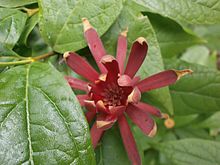Calycanthus floridus
| Calycanthus floridus | |
|---|---|

| |
| Scientific classification | |
| Kingdom: | Plantae |
| Clade: | Tracheophytes |
| Clade: | Angiosperms |
| Clade: | Magnoliids |
| Order: | Laurales |
| Family: | Calycanthaceae |
| Genus: | Calycanthus |
| Species: | C. floridus
|
| Binomial name | |
| Calycanthus floridus L.
| |
Calycanthus floridus, or commonly known as the Eastern Sweetshrub, Carolina All Spice, or Spice Bush,[1] is a species of flowering shrub in the family Calycanthaceae.[2] It is identifiable by its dark red flowers and fragrant scent. It is non-invasive and is found in the southeastern United States Region. Its conservation status is G5, indicating it is low-risk.[3]
Description
Calycanthus floridus is a shrub that grows to be around 6-9’ tall.[4] Its leaves are a dark green with a pale underside. They are ovate or elliptical in shape and grow to be about 6 inches in length.[4] The leaves are simple, entire, and arranged oppositely along the stem.[5]
Inflorescence
Its flowers are solitary, featuring a reddish brown to reddish purple color when they bloom in spring. They are aromatic and so are the leaves when bruised.[4] The flowers have a hypanthium that is more than 2cm long.[6] The shape of the flowers can be cylindrical, ellipsoid, pyriform, or globose.[7] Flowers have numerous tepals that can either be oblong-elliptic or obovate-lanceolate at maturity.[7] The flowers are perfect, having both stamens and carpels on the flowers. The stamens are numerous, connective beyond the anthers.[6] The carpels are numerous. They are free, with a single ovary in a locule.[6]
Fruits
The fruits are indehiscent pseudocarps that are about 8cm in length and 5cm in diameter at maturity.[6] They are formed within the receptacle and contain numerous achenes that are roughly 10mm long with a 5mm diameter.
Distribution and Habitat
Calycanthus floridus is found in Eastern to Southeastern United States, but may also be found in Northeastern states such as New York and Massachusetts.[8] It prefers sunny habitats but can tolerate moderate amounts of shade. It grows well in environments that feature moist substrate.[9] It flowers in the spring to summer season. It is highly resistant to diseases and insects, although it is prone to infection by Agrobacterium tumefaciens, which leads to the formation of crown galls on the stems.[8][10]
Uses
Calycanthus floridus is primarily used for horticulture because the flowers are showy and fragrant.[9] The bark of the plant is edible and is reportedly used as a substitute for cinnamon.[11] The petals of the flower are also reportedly used in tea-making.[11] Strong caution is advised however, as an alkaloid in the plant may lead to heart convulsions.[11] The viscous substance within the plant is reportedly used as a disinfectant.[11]
Pictures


References
- ^ "Calycanthus floridus (Bubby Bush, Carolina Allspice, Common Sweetshrub, Spicebush, Sweet Betsy, Sweet Bubby Bush, Sweetshrub, Sweet Shrub) | North Carolina Extension Gardener Plant Toolbox". plants.ces.ncsu.edu. Retrieved 2020-04-03.
- ^ "Plants Profile for Calycanthus floridus (eastern sweetshrub)". plants.usda.gov. Retrieved 2020-04-03.
- ^ "NatureServe Explorer 2.0". explorer.natureserve.org. Retrieved 2020-04-19.
- ^ a b c "Calycanthus floridus - Plant Finder". www.missouribotanicalgarden.org. Retrieved 2020-04-03.
- ^ "Carolina allspice | The Morton Arboretum". www.mortonarb.org. Retrieved 2020-04-19.
- ^ a b c d Radford, Albert E. (1968). Manual of the vascular flora of the Carolinas. Ahles, Harry E.,, Bell, C. Ritchie. Chapel Hill: University of North Carolina Press. ISBN 0-8078-1087-8. OCLC 355003.
- ^ a b "Calycanthus floridus in Flora of North America @ efloras.org". www.efloras.org. Retrieved 2020-04-03.
- ^ a b "Lady Bird Johnson Wildflower Center - The University of Texas at Austin". www.wildflower.org. Retrieved 2020-04-20.
- ^ a b "Calycanthus floridus | Landscape Plants | Oregon State University". landscapeplants.oregonstate.edu. Retrieved 2020-04-20.
- ^ Gilman, Edward (27 May 2015). "Calycanthus floridus Carolina Allspice, Sweetshrub". EDIS. Retrieved April 16, 2020.
{{cite web}}: CS1 maint: url-status (link) - ^ a b c d "Calycanthus floridus Carolina Allspice, Eastern sweetshrub, Strawberry Bush, Sweetshrub, Carolina Allspice PFAF Plant Database". pfaf.org. Retrieved 2020-04-20.
External links
- USDA, NRCS (n.d.). "Calycanthus floridanus". The PLANTS Database (plants.usda.gov). Greensboro, North Carolina: National Plant Data Team.
 Media related to Calycanthus floridus at Wikimedia Commons
Media related to Calycanthus floridus at Wikimedia Commons
